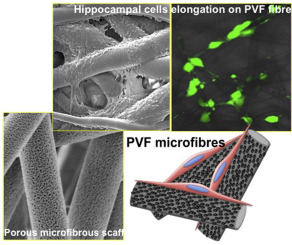Polymer ( IF 4.1 ) Pub Date : 2018-03-12 , DOI: 10.1016/j.polymer.2018.03.021 Muthu Parkkavi Sekar , Purandhi Roopmani , Uma Maheswari Krishnan

|
Tissue engineering strategies are constantly in search of novel scaffold materials that can accelerate cell adhesion, growth and proliferation. In this context, poly(vinyl formal) (PVF), a biodegradable and water absorbing polymer derived from poly(vinyl alcohol) was explored as a potential scaffold material for neural regeneration. No prior attempts have been made to fabricate electrospun fibrous scaffolds from PVF for tissue engineering applications and this forms the focus of the present study. The electrospinning conditions were optimized to obtain defect-free PVF microfibres with an average diameter of 4.4 ± 0.7 μm. The microfibres exhibited a uniform nanoporous surface and a solid core that augmented neuronal cell adhesion and neurite extension. The fibres were brittle and exhibited a 50% degradation in physiological pH and temperature. The viability of hippocampal neuronal cells cultured on the scaffold showed a progressive increase with time revealing its promise as a scaffold material for neural tissue engineering.
中文翻译:

用于神经组织工程的新型多孔聚乙烯醇缩甲醛(PVF)微纤维支架的开发
组织工程策略一直在寻找可以加速细胞粘附,生长和增殖的新型支架材料。在这种情况下,聚(乙烯缩甲醛)(PVF)是一种可生物降解的吸水聚合物,衍生自聚(乙烯醇),是一种潜在的神经再生支架材料。以前没有进行过尝试从PVF制造用于组织工程应用的电纺纤维支架的研究,这构成了本研究的重点。优化静电纺丝条件以获得平均直径为4.4±0.7μm的无缺陷PVF超细纤维。微纤维表现出均匀的纳米孔表面和坚固的核,增加了神经元细胞的粘附和神经突的延伸。纤维是脆性的,并且在生理pH和温度下表现出50%的降解。











































 京公网安备 11010802027423号
京公网安备 11010802027423号